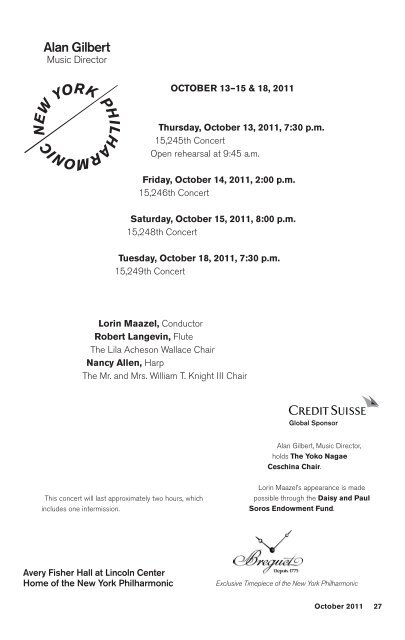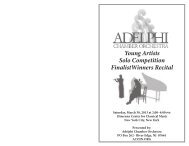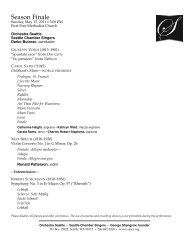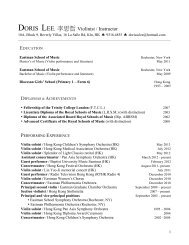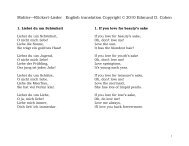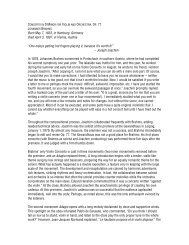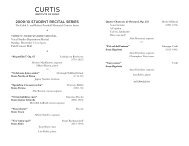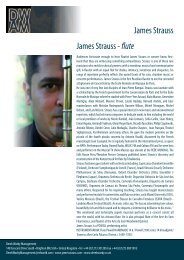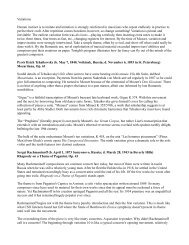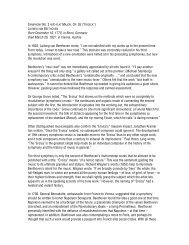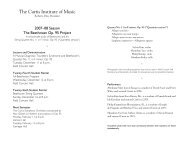download - InstantEncore
download - InstantEncore
download - InstantEncore
You also want an ePaper? Increase the reach of your titles
YUMPU automatically turns print PDFs into web optimized ePapers that Google loves.
10-13 Mahler:Layout 1 10/3/11 11:38 AM Page 27<br />
OCTOBER 13–15 & 18, 2011<br />
Thursday, October 13, 2011, 7:30 p.m.<br />
15,245th Concert<br />
Open rehearsal at 9:45 a.m.<br />
Friday, October 14, 2011, 2:00 p.m.<br />
15,246th Concert<br />
Saturday, October 15, 2011, 8:00 p.m.<br />
15,248th Concert<br />
Tuesday, October 18, 2011, 7:30 p.m.<br />
15,249th Concert<br />
Lorin Maazel, Conductor<br />
Robert Langevin, Flute<br />
The Lila Acheson Wallace Chair<br />
Nancy Allen, Harp<br />
The Mr. and Mrs. William T. Knight III Chair<br />
This concert will last approximately two hours, which<br />
includes one intermission.<br />
Avery Fisher Hall at Lincoln Center<br />
Home of the New York Philharmonic<br />
Global Sponsor<br />
Alan Gilbert, Music Director,<br />
holds The Yoko Nagae<br />
Ceschina Chair.<br />
Lorin Maazel’s appearance is made<br />
possible through the Daisy and Paul<br />
Soros Endowment Fund.<br />
Exclusive Timepiece of the New York Philharmonic<br />
October 2011<br />
27
10-13 Mahler:Layout 1 10/3/11 11:38 AM Page 28<br />
New York Philharmonic<br />
Lorin Maazel, Conductor<br />
Robert Langevin, Flute, The Lila Acheson Wallace Chair<br />
Nancy Allen, Harp, The Mr. and Mrs. William T. Knight III Chair<br />
MOZART Symphony No. 38 in D major, Prague, K.504 (1786)<br />
(1756–91) Adagio — Allegro<br />
Andante<br />
Finale: Presto<br />
MOZART Concerto in C major for Flute and Harp,<br />
K.299/297c (1778)<br />
Allegro<br />
Andantino<br />
Rondeau: Allegro<br />
ROBERT LANGEVIN<br />
NANCY ALLEN<br />
Intermission<br />
DEBUSSY Jeux: Poème dansé (1912–13)<br />
(1862–1918) Très lent — Scherzando (Tempo initial)<br />
DEBUSSY Ibéria, from Images for Orchestra (1905–08)<br />
By the Highways and By-ways<br />
Parfumes of the Night<br />
Morning of a Festival Day<br />
(The second and third movements are played without pause)<br />
28<br />
Classical 105.9 FM WQXR is the Radio Station of<br />
the New York Philharmonic.<br />
The New York Philharmonic This Week,<br />
nationally syndicated on the WFMT Radio Network,<br />
is broadcast 52 weeks per year; visit nyphil.org<br />
for information.<br />
New York Philharmonic<br />
The New York Philharmonic’s concert-recording<br />
series, Alan Gilbert and the New York Philharmonic:<br />
2011–12 Season, will be available for<br />
<strong>download</strong> this fall at all major online music stores.<br />
Visit nyphil.org/recordings for more information.<br />
Follow us on Facebook, Tumblr, Twitter, and<br />
YouTube.<br />
Please be sure that your cell phones and electronic devices have been silenced.
10-13 Mahler:Layout 1 10/3/11 11:38 AM Page 29<br />
Notes on the Program<br />
By James M. Keller, Program Annotator<br />
The Leni and Peter May Chair<br />
Symphony No. 38 in D major,<br />
Prague, K.504<br />
Concerto in C major for Flute<br />
and Harp, K.299/297c<br />
Wolfgang Amadeus Mozart<br />
When Wolfgang Amadeus Mozart left his native<br />
provincial Salzburg for the exciting Austrian<br />
capital of Vienna in 1781, he seems to have<br />
assumed that the world would be his oyster.<br />
This was not to be, however. He met with a<br />
good measure of success, to be sure, gaining<br />
a following as a virtuoso pianist and as a composer<br />
— the latter even in the high-stakes<br />
world of the musical theater — but Vienna<br />
was full of other talented<br />
composers, and many of<br />
them were more politically<br />
savvy than Mozart, whose<br />
genius was often accompanied<br />
by an obstreperous<br />
streak. The decade<br />
he would spend in Vienna<br />
(where he died in 1791)<br />
might be characterized<br />
as a love-hate relationship<br />
in which Mozart<br />
derived important aesthetic<br />
sustenance from<br />
the city’s cultural life<br />
but often felt personally<br />
underappreciated.<br />
Not so Prague — which<br />
Mozart also loved, and<br />
which loved him back.<br />
Germany, Austria, and<br />
In Short<br />
Born: January 27, 1756, in Salzburg, Austria<br />
Died: December 5, 1791, in Vienna<br />
Bohemia shared an active cultural exchange<br />
in the 18th century. In the balance of artistic<br />
trade, Bohemia seems to have been a net exporter:<br />
its gifts to the musical world included<br />
the flotilla of Czech musicians who elevated<br />
Mannheim (in southern Germany) into a midcentury<br />
musical center so prominent that its<br />
orchestra set the standard to which all others<br />
aspired. For all its openness to outsiders,<br />
Prague seems not to have attracted immigrants<br />
quite so easily. Its welcome mat was<br />
out to Mozart, though, and its music-loving<br />
populace was quick to embrace such operas<br />
as Le nozze di Figaro and Don Giovanni unconditionally,<br />
even when Vienna had given<br />
them a more guarded reception. Franz Xaver<br />
Works composed and premiered: Symphony No. 38: composed 1786, in<br />
Vienna; Mozart entered it into his catalogue of compositions on December 6;<br />
premiered apparently January 19, 1787, in Prague, Bohemia (now Czech Republic),<br />
the composer conducting<br />
Concerto for Flute and Harp: composed April 1778 in Paris; we have no information<br />
about the early performance history of this work<br />
New York Philharmonic premieres and most recent performances:<br />
Symphony No. 38: premiered January 27, 1866, Carl Bergmann, conductor; most<br />
recently performed November 10, 2009, Neeme Järvi, conductor<br />
Concerto for Flute and Harp: premiered October 17, 1931, Erich Kleiber, conductor,<br />
John Amans, flute, and Theodore Cella, harp; most recently performed February 24,<br />
2007, Lorin Maazel, conductor, Robert Langevin, flute, and Nancy Allen, harp<br />
Estimated durations: Symphony No. 38: ca. 29 minutes; Concerto for Flute and<br />
Harp: ca. 29 minutes<br />
October 2011<br />
29
10-13 Mahler:Layout 1 10/3/11 11:38 AM Page 30<br />
Niemetschek, the composer’s early biographer,<br />
clarified the difference when recounting<br />
the first performances of Mozart’s Figaro:<br />
In Vienna … they slandered him and did<br />
their best to belittle his art…. [In Prague]<br />
the enthusiasm shown by the public was<br />
without precedent; they could not hear it<br />
enough.<br />
In 1786 Mozart received an invitation to<br />
visit Prague — apparently extended by a coterie<br />
of culturally inclined citizens of the city’s<br />
German-speaking community, well known for<br />
its patriotic support of the Austro-Germanic<br />
arts. At the beginning of 1787 Mozart, his<br />
wife, and a considerable entourage (including<br />
their dog) traveled by coach to the Bohemian<br />
capital for what would be the closest<br />
the composer ever came to a pleasure trip.<br />
His musical obligations were few, limited to<br />
an evening conducting Le nozze di Figaro<br />
and a couple of performances as a pianist,<br />
during which he particularly distinguished<br />
himself as an improviser.<br />
Mozart had arrived bearing gifts, chief<br />
among them the Symphony in D major<br />
that he had completed late in 1786 and that<br />
Listen for … Echoes of Figaro<br />
would forever have the name of “Prague” attached<br />
to it. Mozart led a distinguished<br />
orchestra — albeit a small one of about 20<br />
players — in the work’s premiere, which appears<br />
to have taken place on January 19, 1787.<br />
Years later, in 1808, Niemetschek reported:<br />
the symphonies he composed for this occasion<br />
are real masterpieces … full of surprising<br />
modulations, and have a quick, fiery<br />
gait, so that the very soul is transported to<br />
sublime heights. This applies particularly<br />
to the Symphony in D major, which remains<br />
a favorite in Prague, although it has<br />
doubtless been heard a hundred times.<br />
Indeed, this is one of Mozart’s most impressive<br />
symphonies — in spite of its having<br />
only three movements rather than the by<br />
then traditional four. What’s missing is the<br />
minuet-and-trio that normally occupies the<br />
third movement of a classical symphony. No<br />
one knows why Mozart decided not to include<br />
one, but he more than compensates<br />
for its absence by attaching a slow introduction<br />
to the opening Allegro. Although such<br />
introductions are found in the later symphonies<br />
of Haydn and in those of Beethoven,<br />
Commentators are wont to find both Don Giovanni and Die Zauberflöte prefigured in the Prague Symphony;<br />
but one might just as easily hear reflections of the good-humored wisdom of Le nozze di Figaro as the moody<br />
introduction gives way to the main stretch of the first movement, where the drama of quiet syncopations gives<br />
way to jubilant outbursts from the trumpets and timpani. The spirit of Figaro again returns with the concluding<br />
Presto — and quite directly so, since its main theme is derived from that opera, or in any case relates closely<br />
to the fleeting duet between Susanna and Cherubino (Act II, scene 7) that culminates in the latter leaping from<br />
the window of the Countess’s boudoir:<br />
Mozart wrote this movement at about the same time he was completing Figaro. Just why he embarked on a<br />
stand-alone D-major symphonic Presto in the spring of 1786 remains a mystery, but, practical craftsman that<br />
he was, Mozart found a use for it later that year and built the rest of his symphony to fit with it.<br />
30<br />
New York Philharmonic
10-13 Mahler:Layout 1 10/3/11 11:38 AM Page 31<br />
they are not much associated with Mozart. In<br />
this opening, Mozart seems to be looking<br />
ahead to the perplexing chromatic ruminations<br />
of Don Giovanni, which, as it happens,<br />
Prague would giddily idolize within a year.<br />
By the time Mozart turned 21, in January<br />
1777, he had already experienced more of<br />
the world than most young adults of any era<br />
would approach in a lifetime. As a child<br />
prodigy, he had impressed musical connoisseurs<br />
and had entertained crowned heads in<br />
At the Time<br />
many European capitals. When he reached<br />
his majority, Mozart’s compositions at least<br />
equaled and often surpassed the best work<br />
of his contemporaries, and he had begun to<br />
make a mark in all the major genres. However,<br />
the young composer felt repressed in<br />
what he viewed as the artistic backwater of<br />
Salzburg, and he yearned to pursue his career<br />
elsewhere.<br />
In September 1777 Mozart and his mother<br />
embarked on a journey north and west, tracing<br />
a route from their home in Salzburg to<br />
In the years 1786–87, when Mozart composed and premiered his Symphony No. 38, the following events were<br />
taking place:<br />
1786: Jacques Balmat and Dr. Michel-Gabriel Paccard become the first<br />
men to climb France’s Mont Blanc; Robert Burns (top right) publishes<br />
Poems, Chiefly in the Scottish Dialect, his first book of poetry; Charles<br />
Cornwallis, whose surrender to American forces at Yorktown signaled<br />
the end of major fighting in the American Revolution, is appointed governor-general<br />
of India; George Washington calls for the abolition of slavery;<br />
the Necklace Affair (“L’Affiare du Collier”) trial ends in Paris; Reykjavík,<br />
the capital of Iceland, is founded; Johann Wolfgang von Goethe embarks<br />
on his travels to Italy; Daniel Shays, a Revolutionary War veteran, leads a<br />
rebellion that begins in Springfield, Massachusetts, to protest evictions<br />
and seizure of property for non-payment of debts<br />
1787: William Herschel discovers Titania and Oberon, moons of<br />
Uranus; Milan’s Teatro alla Scala is built by Giuseppe Piermarini<br />
(center); the Constitutional Convention convenes in Philadelphia<br />
(bottom); Morocco becomes the first country to recognize<br />
the United States as a sovereign nation; the Ottoman Empire<br />
declares war on Russia; Irish painter Robert Barker invents and<br />
patents the panorama; the first left and right shoes are made;<br />
Alexander Hamilton becomes the first U.S. Treasury secretary;<br />
the Constitution of the United States is completed and signed,<br />
going into effect on March 4; the first ships carrying convicts<br />
leave Great Britain for Australia’s Botany Bay<br />
(penal transports will continue until 1853)<br />
— The Editors<br />
October 2011 31
10-13 Mahler:Layout 1 10/3/11 11:38 AM Page 32<br />
distant Paris, with visits in Munich and Augsburg<br />
and a lengthy stay in Mannheim along<br />
the way. The composer’s father, Leopold, remained<br />
at home; the family could not subsist<br />
without the income he earned there. “The<br />
purpose of the journey,” Leopold reminded<br />
his son in a letter on November 27, “the sole<br />
purpose, was, is, and must be to obtain a position<br />
or earn some money.” Mozart failed to<br />
accomplish the former, although he claimed<br />
to have turned down a well-paying post as<br />
an organist at Versailles. In any case, the<br />
money he acquired from composing, performing,<br />
and teaching during his months<br />
away wouldn’t have been impressive even if<br />
he had been paid as promised for his engagements,<br />
which on numerous occasions<br />
he was not. Tragedy struck on July 3, 1778,<br />
when Mozart’s mother died as the result of a<br />
sudden illness. The 22-year-old composer<br />
(who had never before been without parental<br />
supervision) was left to make burial arrangements,<br />
break the news to his father and sister<br />
back home, and struggle on in a foreign<br />
country before making his way back to<br />
Salzburg, where he arrived in January 1779,<br />
dreading his return to the provincial routine<br />
he had hoped to escape.<br />
During the six months that Mozart had<br />
spent in Paris he made serious efforts to<br />
stake a place in that metropolis’s musical life.<br />
Immediately after his arrival on March 23,<br />
1778, he sought out an old family friend,<br />
Baron von Grimm, who had opened numerous<br />
Parisian doors when the Mozarts had<br />
visited Paris in 1763. The Baron again<br />
alerted his aristocratic circle, but the jobseeking<br />
adult Mozart was a harder sell than<br />
the seven-year-old prodigy had been, and he<br />
was received into Parisian salons with less<br />
excitement, if at all. Leopold, who in his barrage<br />
of correspondence proved to be a veritable<br />
Niagara of advice, reminded his son<br />
32<br />
New York Philharmonic<br />
Mozart and the Flute<br />
Mozart, 1789<br />
Much has been made of the fact that Mozart once<br />
spoke disparagingly of the flute. “I am quite inhibited<br />
when I have to compose for an instrument which I<br />
cannot endure,” he wrote to his father (from<br />
Mannheim on February 14, 1778, while on his way to<br />
Paris). It was the end of a litany of excuses<br />
explaining why he had not yet fulfilled a commission<br />
for some flute concertos (though he had found<br />
plenty of time to spend with his then girlfriend).<br />
This comment, clearly made in a snit, is often<br />
cited as proof that Mozart truly loathed the flute. It is<br />
weak evidence, especially since the composer never<br />
repeated anything to that effect in his remaining<br />
years, and since he would spotlight that instrument<br />
sensitively in many of his symphonies and operas, in<br />
addition to his two flute concertos (which he<br />
eventually did finish) and his four flute quartets, as<br />
well as the Flute and Harp Concerto. Would a<br />
composer who detested the flute have permitted it<br />
to serve as the “title character” of Die Zauberflöte<br />
(The Magic Flute), where it is exalted as a repository<br />
of mystical powers of salvation? In the end, the<br />
music would seem to put this question to rest. If<br />
Mozart really had misgivings about the instrument,<br />
listening to the concerto that he himself wrote for it<br />
would probably have converted him.<br />
(on April 20) to “be guided by the French<br />
taste” while in Paris (italics his). “If you only<br />
win applause and get a decent sum of<br />
money, let the devil take the rest.”
10-13 Mahler:Layout 1 10/3/11 11:38 AM Page 33<br />
Leopold was responding to a letter that his<br />
wife had sent him two weeks earlier that had<br />
reported that Wolfgang was already busy with<br />
several projects, among them “two concertos,<br />
one for the flute and the other for the harp.”<br />
She had it not quite right: it was one concerto<br />
for both instruments together, and in writing it<br />
Mozart was indeed taking his father’s advice<br />
about being guided by French taste, since the<br />
particular passion of French audiences just<br />
then was the symphonie concertante, effectively<br />
a concerto with multiple soloists.<br />
Mozart wrote the piece for a friend of<br />
Baron Grimm’s: the Duc de Guînes, an accomplished<br />
flutist whose daughter was receiving<br />
daily two-hour composition lessons<br />
from Mozart. As in much of Mozart’s music<br />
“in the French taste,” this concerto treads<br />
lightly in matters of harmonic bravery, but<br />
it makes up for that in its abundance of<br />
Angels and Muses<br />
melodic invention and the sheer sonic beauty<br />
of the instrumental combination. The concerto’s<br />
success was more aesthetic than pecuniary:<br />
by the end of July Mozart had still<br />
not been paid for the work; in addition, the<br />
duke tried to stiff him of half the money for<br />
his daughter’s lessons.<br />
Instrumentation: The Symphony No. 38<br />
employs two flutes, two oboes, two bassoons,<br />
two horns, two trumpets, timpani, and<br />
strings. The Concerto in C major for Flute<br />
and Harp calls for two oboes, two horns, and<br />
strings, in addition to the solo flute and harp.<br />
Cadenzas: As Mozart provided no cadenzas,<br />
though he calls for them in all three<br />
movements, the soloists in this performance<br />
of the Concerto for Flute and Harp play<br />
those crafted by Karl Hermann Pillney.<br />
Mozart composed his Flute and Harp Concerto on commission from Adrien-Louis de Bonnières de Souastre,<br />
Duc de Guînes (1735–1806). This music-loving aristocrat (who played the flute) had started life as a mere count,<br />
distinguished himself as a soldier in the Seven Years War, and served as French Ambassador to Berlin (where<br />
he had played flute duets with Frederick the Great) and to London (from whence he was recalled for financial<br />
improprieties). On returning to France, in 1776, he was elevated to the status of duke, and in 1788 was named<br />
Governor of Artois. On May 14, 1778, Mozart wrote to his father about the Duc de Guînes, “whose daughter is my<br />
pupil in composition, plays the flute extremely well, and … plays the harp magnifique.” He continued:<br />
She has a great deal of talent and even genius, and in particular a<br />
marvelous memory, so that she can play all her pieces,<br />
actually about 200, by heart. She is, however, extremely<br />
doubtful as to whether she has any talent for<br />
composition, especially as regards invention or<br />
ideas. But her father who, between ourselves, is<br />
somewhat too infatuated with her, declares that<br />
she certainly has ideas and that it is only that she<br />
is too bashful and has too little self-confidence.<br />
Well, we shall see. If she gets no inspiration or<br />
ideas (for at present she really has none<br />
whatever), then it is to no purpose, for — God<br />
knows — I can’t give her any. Her father’s intention<br />
is not to make a great composer of her. “She is not,”<br />
he said, “to compose operas, arias, concertos, sym pho -<br />
nies, but only grand sonatas for her instrument and mine.”<br />
The Concert, attributed to Jean-Honoré Fragonard<br />
October 2011<br />
33
10-13 Mahler:Layout 1 10/3/11 11:38 AM Page 34<br />
Jeux: Poème-dansé<br />
Ibéria, from Images for<br />
Orchestra<br />
Claude Debussy<br />
Claude Debussy developed a knotty relationship<br />
with the stage. He carried out work<br />
in each of the three principal stage genres:<br />
opera, ballet, and incidental music for plays.<br />
Yet he managed to complete only a single<br />
example of each — Pelléas et Mélisande,<br />
Jeux, and Le Martyre de Saint Sébastien, respectively,<br />
leaving numerous other attempts<br />
in various stages of incompletion. So far as<br />
ballet is concerned, he had essentially fulfilled<br />
a commission (between 1910 and<br />
1912) for a piece titled Khamma for the<br />
choreographer Maud Allan, though he left<br />
the orchestration to his fellow composer<br />
Charles Koechlin; but the piece never received<br />
even a concert performance until 1924 (six<br />
years after Debussy’s death) and did not<br />
reach the stage until<br />
1947. It remains largely<br />
unheard today. Two other<br />
ballet scores also remained<br />
incomplete: the<br />
children’s ballet La Boîte<br />
à joujoux of 1913 (which<br />
made it up to the orchestration<br />
stage), and<br />
No-ja-li (Le palais du silence)<br />
of 1913–14.<br />
In posterity, the score<br />
for Jeux (Games) has<br />
made up for the lack of<br />
the others. It is Debussy’s<br />
last completed<br />
orchestral work, and it<br />
has been cited as an essential<br />
point of departure<br />
for a certain strand<br />
34 New York Philharmonic<br />
In Short<br />
of later composers. Pierre Boulez maintained<br />
that it signified:<br />
the arrival of a kind of musical form which,<br />
renewing itself from moment to moment,<br />
implies a similarly instantaneous mode of<br />
perception.<br />
Debussy composed it for the impresario<br />
Serge Diaghilev, whose Ballets Russes —<br />
launched in Paris in 1909 — became quickly<br />
identified with the vanguard of the European<br />
arts scene. Diaghilev soon commissioned new<br />
ballet scores, of which the very first was<br />
Stravinsky’s Firebird, premiered in 1910. More<br />
Stravinsky followed, including Petrushka, premiered<br />
in 1911, and Le Sacre du printemps<br />
(The Rite of Spring) on May 29, 1913 — a<br />
date that earned legendary status thanks to<br />
the riot that broke out at its premiere. That<br />
event eclipsed the more minor disappointment<br />
that precisely two weeks earlier had attended<br />
the premiere of Jeux, with a score by Debussy.<br />
Born: August 22, 1862, in St. Germain-en-Laye, just outside Paris, France<br />
Died: March 25, 1918, in Paris<br />
Works composed and premiered: Jeux: composed 1912–13, but largely in<br />
August 1913; premiered May 15, 1913, in a staged production by the Ballets<br />
Russes at the Théâtre des Champs-Élysées, Pierre Monteux, conductor; it was<br />
given the following year in concert form by the Orchestre des Concerts Colonne,<br />
conducted by Gabriel Pierné.<br />
Ibéria: begun in 1905 as a piano duet; completed as an orchestral work on<br />
December 25, 1908; premiered February 20, 1910, Gabriel Pierné conducting<br />
the Orchestre des Concerts Colonne in Paris<br />
New York Philharmonic premieres and most recent performances:<br />
Jeux: premiered January 13, 1938, Georges Enesco, conductor; most recently<br />
performed March 18, 1986, Pierre Boulez, conductor<br />
Ibéria: premiered January 3, 1911, Gustav Mahler, conductor; most recently<br />
performed February 13, 2007, Alan Gilbert, conductor<br />
Estimated durations: Jeux: ca. 18 minutes; Ibéria: ca. 20 minutes
10-13 Mahler:Layout 1 10/3/11 11:38 AM Page 35<br />
The concept of Jeux was expounded by<br />
the dancer Vaslav Nijinsky over lunch with<br />
Diaghilev and the designer Léon Bakst at<br />
the Savoy Hotel in London, the notes being<br />
jotted down on the tablecloth. The event was<br />
recounted to the painter Jacques-Émile<br />
Blanche, who, in his memoirs, related the scenario<br />
drawn up on that occasion:<br />
There should be no corps de ballet, no ensembles,<br />
no variations, no pas de deux,<br />
only boys and girls in flannels and rhythmic<br />
movement. A group at a certain stage was<br />
to depict a fountain, and a game of tennis<br />
was to be interrupted by the crashing of<br />
an aeroplane.<br />
Nijinsky also detailed this work’s genesis<br />
in his diary, adding the detail that the action<br />
would depict the story of “three young men<br />
making love to each other.” It fell to Blanche<br />
to telegraph the concept to Debussy. The<br />
composer immediately responded “I should<br />
not dream of writing a score for this work,”<br />
but then amended his answer to say that he<br />
could find a way to write it after all, if his fee<br />
were to be doubled.<br />
In the end, the plane crash was blessedly<br />
eliminated and the three young men Nijinsky<br />
imagined were turned into one young man and<br />
two young women. Nijinsky ended up falling<br />
out of love with the project, but Debussy seems<br />
to have warmed to it, producing his score with<br />
uncharacteristic speed, apparently within the<br />
course of about three weeks in August 1913.<br />
Near the end of the month he wrote to his<br />
friend, the composer André Caplet:<br />
How was I able to forget the cares of this<br />
world and manage to write music that is<br />
nevertheless joyous and alive with droll<br />
rhythms? Nature, so absurdly harsh, sometimes<br />
takes pity, it seems, on her children.<br />
Sources and Inspirations<br />
Nijinsky’s initial inspirations for the ballet Jeux<br />
underwent a considerable amount of refinement,<br />
eventually yielding this scenario, which was supplied<br />
to Debussy as the foundation on which he should<br />
construct his score:<br />
In a park, at dusk, a tennis ball goes astray; a<br />
young man, then two young women hurriedly try to<br />
find it. The artificial light of huge electric lamps<br />
casts its fantastic gleam about them and suggests<br />
the idea of children’s games; they play hide-andseek,<br />
run after each other, quarrel and sulk for no<br />
good reason; the night is warm, the sky bathed in<br />
gentle light, they kiss. But the spell is broken by a<br />
tennis ball thrown by some malicious hand. Surprised<br />
and frightened, the young man and two<br />
young women disappear into the depths of the<br />
night-enshrouded park.<br />
Nonetheless, Debussy hated Nijinsky’s<br />
choreography and he was glad to be rid of the<br />
ballet, which was poorly received. While the<br />
performance was underway on opening night,<br />
he left his box to smoke a cigarette outside.<br />
Almost 10 years earlier the final work on this<br />
program, Ibéria,, had been premiered. The<br />
Spanish composer Manuel de Falla wrote in<br />
an article he contributed to an all-Debussy<br />
issue of the Revue musicale, published in<br />
December 1920:<br />
Without knowing Spain, or without having<br />
set foot on Spanish ground, Claude Debussy<br />
has written Spanish music. He came<br />
to know Spain through books and paintings,<br />
through songs and dances performed<br />
by native Spaniards.<br />
He continued, replete with admiration:<br />
Debussy, who did not actually know Spain,<br />
spontaneously — I dare say unconsciously —<br />
October 2011<br />
35
10-13 Mahler:Layout 1 10/3/11 11:38 AM Page 36<br />
Debussy in May 1902<br />
In the Composer’s Words<br />
Debussy may have insisted that IIbbéérriiaa was not based<br />
on any plot or program, but in a letter to his colleague<br />
André Caplet, written six days after the work’s premiere,<br />
he revealed just how specific his imagery was:<br />
You can’t imagine how naturally the transition works<br />
between Parfumes of the Night and Morning of a<br />
Festival Day. It sounds as though it’s improvised. …<br />
The way it comes to life, with people and things<br />
waking up ….. There’s a man selling watermelons<br />
and urchins whistling: I see them all quite clearly.<br />
created such Spanish music as was to<br />
arouse the envy of many who knew Spain<br />
only too well. He crossed the border only<br />
once, and stayed for a few hours in San Sebastián<br />
to attend a bullfight: little enough<br />
experience indeed. However, he kept a vivid<br />
memory of the unique light in the bullring, of<br />
the astonishing contrast between the side<br />
flooded by sunlight and the one in shadow.<br />
Perhaps an evocation of that afternoon<br />
passed on Spain’s threshold is to be found<br />
in Morning of a Festival Day from Ibéria.<br />
Debussy’s Spain, then, was a romantic<br />
Spain born of fantasy. It was an imaginary<br />
journey the composer would take often and<br />
would inspire a number of compositions.<br />
Some proclaimed their Spanish connection<br />
explicitly, such as his piano piece La Soirée<br />
dans Grenade (from Estampes), while others<br />
36 New York Philharmonic<br />
reflected it more subtly through the specific<br />
sounds of their music, as when the string<br />
players mimic the strumming of a guitar in<br />
the second movement of his String Quartet.<br />
Falla applauded Debussy’s achievements<br />
as revelatory for Spanish composers themselves.<br />
“While the Spanish composer to a<br />
large extent uses in his music the authentic<br />
popular material,” Falla wrote,<br />
the French master avoids them and creates a<br />
music of his own, borrowing only the essence<br />
of its fundamental elements. There is still another<br />
interesting fact regarding the particular<br />
texture of Debussy’s music. In Andalusia they<br />
are produced on the guitar in the most spontaneous<br />
way. It is curious that Spanish composers<br />
have neglected, even despised as<br />
barbaric, those effects, or they have adapted<br />
them to the old musical procedures. Debussy<br />
has taught the way to use them.<br />
Ibéria is the most imposing of Debussy’s<br />
imaginary “postcards from Spain,” occupying<br />
three full movements for a colorfully constituted<br />
orchestra, themselves the central<br />
group of the composer’s symphonic triptych<br />
Images. (Although Debussy titled the set only<br />
Images, it is commonly referred to as Images<br />
for Orchestra to distinguish it from his two<br />
earlier sets of Images for piano.) The three<br />
Images for Orchestra drew on national music<br />
from different lands — the first part, Gigues,<br />
evokes English folk dance; the third, Rondes<br />
de printemps, portrays an Italian May Day<br />
celebration — and as a whole they occupied<br />
him for some eight years. He began Ibéria in<br />
1905 and by the following July reported to<br />
his publisher that he expected to complete it<br />
by the next week. Two and a half years later<br />
he finally did finish it, and by that time what<br />
he had envisioned as a work for piano duet<br />
had grown into a score for full orchestra.
10-13 Mahler:Layout 1 10/3/11 11:38 AM Page 37<br />
“It is useless to ask me for anecdotes about<br />
this work,” Debussy protested to the exasperated<br />
program annotator charged with producing<br />
materials to accompany the premiere of<br />
Ibéria, in 1910. “There is no story attached to<br />
it, and I depend on the music alone to arouse<br />
the interest of the public.” Even if Ibéria has<br />
no extramusical plot, the scenes it evokes are<br />
nonetheless specific. The first movement is a<br />
street scene, its brilliant light thrown into<br />
greater relief by the shadowy contrast heard<br />
midway. Mystery pervades the night air in the<br />
second movement. And the third, which follows<br />
without pause, vividly portrays a festival.<br />
Sources and Inspirations<br />
Instrumentation: Jeux calls for two flutes<br />
and two piccolos, three oboes and English<br />
horn, three clarinets and bass clarinet, three<br />
bassoons and contrabassoon, four horns,<br />
four trumpets, three trombones, tuba, timpani,<br />
tambourine, triangle, cymbals, xylophone,<br />
celesta, two harps, and strings. Ibéria<br />
employs three flutes (one doubling piccolo)<br />
and piccolo, two oboes and English horn,<br />
three clarinets, three bassoons and contrabassoon,<br />
four horns, three trumpets, three<br />
trombones, tuba, timpani, tambourine, castanets,<br />
snare drum, xylophone, chimes, two<br />
harps, celesta, and strings.<br />
The three pieces of Debussy’s Images evoke three different cultures: Gigues points to England, with its use of<br />
the Northumbrian folk song “The Keel Row,” and Rondes du printemps draws on two French folk songs, “Nous<br />
n’irons plus au bois,” and “Do, l’enfant, do.” IIbbéérriiaa contains no specific national musical references to Spain, but<br />
a Spanish feeling can surely be felt throughout it, so much so that it could surprise a listener to learn that Debussy<br />
had never spent any significant time in that country. The Spanish composer Manual de Falla inferred that<br />
his French colleague had learned the sights, sounds, scents, and sense of Spain through the art created by<br />
Spaniards, such as Joaquín Sorolla y Bastida (1863–1923).<br />
— The Editors<br />
Sorolla’s Beach at Valencia or Afternoon Sun, 1908<br />
October 2011<br />
37
10-13 Mahler:Layout 1 10/3/11 11:38 AM Page 38<br />
New York Philharmonic<br />
2011–2012 SEASON<br />
ALAN GILBERT, Music Director, The Yoko Nagae Ceschina Chair<br />
Case Scaglione, Assistant Conductor<br />
Joshua Weilerstein, Assistant Conductor<br />
Leonard Bernstein, Laureate Conductor, 1943–1990<br />
Kurt Masur, Music Director Emeritus<br />
VIOLINS<br />
Glenn Dicterow<br />
Concertmaster<br />
The Charles E. Culpeper<br />
Chair<br />
Sheryl Staples<br />
Principal Associate<br />
Concertmaster<br />
The Elizabeth G. Beinecke<br />
Chair<br />
Michelle Kim<br />
Assistant Concertmaster<br />
The William Petschek<br />
Family Chair<br />
Enrico Di Cecco<br />
Carol Webb<br />
Yoko Takebe<br />
Hae-Young Ham<br />
The Mr. and Mrs. Timothy<br />
M. George Chair<br />
Lisa GiHae Kim<br />
Kuan-Cheng Lu<br />
Newton Mansfield<br />
The Edward and Priscilla<br />
Pilcher Chair<br />
Kerry McDermott<br />
Anna Rabinova<br />
Charles Rex<br />
The Shirley Bacot Shamel<br />
Chair<br />
Fiona Simon<br />
Sharon Yamada<br />
Elizabeth Zeltser<br />
The William and Elfriede<br />
Ulrich Chair<br />
Yulia Ziskel<br />
Marc Ginsberg<br />
Principal<br />
Lisa Kim*<br />
In Memory of Laura Mitchell<br />
Soohyun Kwon<br />
The Joan and Joel I. Picket<br />
Chair<br />
Duoming Ba<br />
38 New York Philharmonic<br />
Marilyn Dubow<br />
The Sue and Eugene<br />
Mercy, Jr. Chair<br />
Martin Eshelman<br />
Quan Ge<br />
The Gary W. Parr Chair<br />
Judith Ginsberg<br />
Stephanie Jeong+<br />
Hanna Lachert<br />
Hyunju Lee<br />
Joo Young Oh<br />
Daniel Reed<br />
Mark Schmoockler<br />
Na Sun<br />
Vladimir Tsypin<br />
VIOLAS<br />
Cynthia Phelps<br />
Principal<br />
The Mr. and Mrs. Frederick<br />
P. Rose Chair<br />
Rebecca Young*<br />
Irene Breslaw**<br />
The Norma and Lloyd<br />
Chazen Chair<br />
Dorian Rence<br />
Katherine Greene<br />
The Mr. and Mrs. William J.<br />
McDonough Chair<br />
Dawn Hannay<br />
Vivek Kamath<br />
Peter Kenote<br />
Kenneth Mirkin<br />
Judith Nelson<br />
Robert Rinehart<br />
The Mr. and Mrs. G. Chris<br />
Andersen Chair<br />
CELLOS<br />
Carter Brey<br />
Principal<br />
The Fan Fox and Leslie R.<br />
Samuels Chair<br />
Eileen Moon*<br />
The Paul and Diane<br />
Guenther Chair<br />
Eric Bartlett<br />
The Shirley and Jon<br />
Brodsky Foundation Chair<br />
Maria Kitsopoulos<br />
Elizabeth Dyson<br />
The Mr. and Mrs. James E.<br />
Buckman Chair<br />
Sumire Kudo<br />
Qiang Tu<br />
Ru-Pei Yeh<br />
The Credit Suisse Chair<br />
in honor of Paul Calello<br />
Wei Yu<br />
Wilhelmina Smith++<br />
BASSES<br />
Timothy Cobb++<br />
Acting Principal<br />
The Redfield D. Beckwith<br />
Chair<br />
Orin O’Brien*<br />
Acting Associate Principal<br />
The Herbert M. Citrin Chair<br />
William Blossom<br />
The Ludmila S. and Carl B.<br />
Hess Chair<br />
Randall Butler<br />
David J. Grossman<br />
Satoshi Okamoto<br />
FLUTES<br />
Robert Langevin<br />
Principal<br />
The Lila Acheson Wallace<br />
Chair<br />
Sandra Church*<br />
Mindy Kaufman<br />
PICCOLO<br />
Mindy Kaufman<br />
OBOES<br />
Liang Wang<br />
Principal<br />
The Alice Tully Chair<br />
Sherry Sylar*<br />
Robert Botti<br />
The Lizabeth and Frank<br />
Newman Chair<br />
ENGLISH HORN<br />
The Joan and Joel Smilow<br />
Chair<br />
CLARINETS<br />
Mark Nuccio<br />
Acting Principal<br />
The Edna and W. Van Alan<br />
Clark Chair<br />
Pascual Martinez<br />
Forteza*<br />
Acting Associate Principal<br />
The Honey M. Kurtz Family<br />
Chair<br />
Alucia Scalzo++<br />
Amy Zoloto++<br />
E-FLAT CLARINET<br />
Pascual Martinez<br />
Forteza<br />
BASS CLARINET<br />
Amy Zoloto++<br />
BASSOONS<br />
Judith LeClair<br />
Principal<br />
The Pels Family Chair<br />
Kim Laskowski*<br />
Roger Nye<br />
Arlen Fast<br />
CONTRABASSOON<br />
Arlen Fast
10-13 Mahler:Layout 1 10/3/11 11:38 AM Page 39<br />
HORNS<br />
Philip Myers<br />
Principal<br />
The Ruth F. and Alan J. Broder Chair<br />
Stewart Rose++*<br />
Acting Associate Principal<br />
Cara Kizer Aneff<br />
R. Allen Spanjer<br />
Howard Wall<br />
David Smith++<br />
TRUMPETS<br />
Philip Smith<br />
Principal<br />
The Paula Levin Chair<br />
Matthew Muckey*<br />
Ethan Bensdorf<br />
Thomas V. Smith<br />
TROMBONES<br />
Joseph Alessi<br />
Principal<br />
The Gurnee F. and Marjorie L. Hart<br />
Chair<br />
Daniele Morandini*<br />
Acting Associate Principal<br />
David Finlayson<br />
The Donna and Benjamin M. Rosen<br />
Chair<br />
BASS TROMBONE<br />
James Markey<br />
The Daria L. and William C. Foster<br />
Chair<br />
TUBA<br />
Alan Baer<br />
Principal<br />
TIMPANI<br />
Markus Rhoten<br />
Principal<br />
The Carlos Moseley Chair<br />
Kyle Zerna**<br />
PERCUSSION<br />
Christopher S. Lamb<br />
Principal<br />
The Constance R. Hoguet Friends of<br />
the Philharmonic Chair<br />
Daniel Druckman*<br />
The Mr. and Mrs. Ronald J. Ulrich<br />
Chair<br />
Kyle Zerna<br />
HARP<br />
Nancy Allen<br />
Principal<br />
The Mr. and Mrs. William T. Knight III<br />
Chair<br />
KEYBOARD<br />
In Memory of Paul Jacobs<br />
HARPSICHORD<br />
Lionel Party<br />
PIANO<br />
The Karen and Richard S. LeFrak<br />
Chair<br />
Harriet Wingreen<br />
Jonathan Feldman<br />
ORGAN<br />
Kent Tritle<br />
LIBRARIANS<br />
Lawrence Tarlow<br />
Principal<br />
Sandra Pearson**<br />
Sara Griffin**<br />
ORCHESTRA PERSONNEL<br />
MANAGER<br />
Carl R. Schiebler<br />
STAGE REPRESENTATIVE<br />
Louis J. Patalano<br />
AUDIO DIRECTOR<br />
Lawrence Rock<br />
* Associate Principal<br />
** Assistant Principal<br />
+ On Leave<br />
++ Replacement/Extra<br />
The New York Philharmonic uses<br />
the revolving seating method for<br />
section string players who are<br />
listed alpha betically in the roster.<br />
HONORARY MEMBERS OF THE<br />
SOCIETY<br />
Emanuel Ax<br />
Pierre Boulez<br />
Stanley Drucker<br />
Lorin Maazel<br />
Zubin Mehta<br />
Carlos Moseley<br />
Instruments made possible, in part, by<br />
The Richard S. and Karen<br />
LeFrak Endowment Fund.<br />
Programs are supported, in part, by<br />
public funds from the New York<br />
City Department of Cultural<br />
Affairs, New York State Council<br />
on the Arts, and the National<br />
Endowment for the Arts.<br />
Steinway is the Official Piano of<br />
the New York Philharmonic and<br />
Avery Fisher Hall.<br />
October 2011<br />
39
10-13 Mahler:Layout 1 10/3/11 11:38 AM Page 40<br />
The Artists<br />
Lorin Maazel served as Music Director of<br />
the New York Philharmonic from 2002 to<br />
2009. In the 2010–11 season he completed<br />
his fifth and final year as the inaugural music<br />
director of the Palau de les Arts Reina Sofia<br />
opera house in Valencia, Spain, and at the<br />
start of the 2012–13 season he will become<br />
music director of the Munich Philharmonic.<br />
Mr. Maazel is also the founder and artistic director<br />
of the Castleton Festival, based on his<br />
farm property in Virginia, which was launched<br />
to great acclaim in 2009. The festival is expanding<br />
its activities nationally and internationally<br />
in 2011 and beyond.<br />
Mr. Maazel is also a composer, with a<br />
wide-ranging catalogue of works written primarily<br />
over the last dozen years. His first<br />
opera, 1984, based on George Orwell’s literary<br />
masterpiece, had its world premiere at<br />
the Royal Opera House, Covent Garden, in<br />
May 2005, and was revived at Milan’s Teatro<br />
40 New York Philharmonic<br />
alla Scala in May 2008. A Decca DVD of the<br />
original London production was released in<br />
May 2008.<br />
A second-generation American born in<br />
Paris, France, Lorin Maazel began violin lessons<br />
at age five, and conducting lessons at<br />
age seven. He studied with Vladimir Baka -<br />
leinikoff, and appeared publicly for the first<br />
time at age eight. Between ages nine and fifteen<br />
he conducted most of the major American<br />
orchestras, including the NBC Symphony<br />
at the invitation of Arturo Toscanini. In the<br />
course of his decades-long career Mr. Maazel<br />
has conducted more than 150 orchestras in<br />
no fewer than 5,000 opera and concert performances.<br />
He has made more than 300<br />
recordings, including symphonic cycles of<br />
complete orchestral works by Beethoven,<br />
Brahms, Debussy, Mahler, Schubert, Tchai -<br />
kovsky, Rachmaninoff, and Richard Strauss,<br />
winning 10 Grands Prix du Disques.<br />
Lorin Maazel has been music director of<br />
the Bavarian Radio Symphony Orchestra<br />
(1993–2002); music director of the Pittsburgh<br />
Symphony (1988–96); general manager<br />
and chief conductor of the Vienna<br />
Staatsoper (1982–84, the first American to<br />
hold that position); music director of The<br />
Cleveland Orchestra (1972–82); and artistic<br />
director and chief conductor of the Deutsche<br />
Oper Berlin (1965–71). His close association<br />
with the Vienna Philharmonic has included<br />
11 internationally televised New<br />
Year’s Concerts from Vienna.
10-13 Mahler:Layout 1 10/3/11 11:38 AM Page 41<br />
Robert Langevin joined the New York Philharmonic<br />
as Principal Flute, The Lila Acheson<br />
Wallace Chair, in the 2000–01 season. In May<br />
2001 he made his solo debut with the Orchestra<br />
in the U.S. premiere of Siegfried<br />
Matthus’s Concerto for Flute and Harp with<br />
Philharmonic Principal Harp Nancy Allen, led<br />
by then Music Director Kurt Masur. Prior to the<br />
Philharmonic, Mr. Langevin held the Jackman<br />
Pfouts Principal Flute Chair of the Pittsburgh<br />
Symphony, was an adjunct professor at<br />
Duquesne University in Pittsburgh, and served<br />
as associate principal of the Montreal Symphony<br />
Orchestra for 13 years. As a member<br />
of Musica Camerata Montreal and l’Ensemble<br />
de la Société de Musique Contemporaine du<br />
Québec, he premiered many works, including<br />
the Canadian premiere of Pierre Boulez’s Le<br />
Marteau sans maître. In addition, Mr. Langevin<br />
has performed as soloist with Quebec’s most<br />
distinguished ensembles and has recorded<br />
many recitals and chamber music programs<br />
for the Canadian Broadcasting Corporation.<br />
He also served on the faculty of the University<br />
of Montreal for nine years.<br />
Born in Sherbrooke, Quebec, Robert<br />
Langevin won the prestigious Prix d’Europe, a<br />
national competition open to all instruments<br />
with a first prize of a two-year scholarship to<br />
study in Europe. He subsequently worked<br />
with Aurèle Nicolet at the Staatliche<br />
Hochschule für Musik in Freiburg, Germany,<br />
from which he graduated in 1979. He also<br />
studied with Maxence Larrieu in Geneva, winning<br />
second prize at the Budapest International<br />
Competition in 1980. Robert Langevin is a<br />
member of the Philharmonic Quintet of New<br />
York, and has given recitals and master classes<br />
throughout the United States and abroad.<br />
Nancy Allen joined the New York Philharmonic<br />
in June 1999 as Principal Harp, The<br />
Mr. and Mrs. William T. Knight III Chair. She<br />
maintains a busy international concert schedule<br />
as well as heading the harp departments of<br />
The Juilliard School and the Aspen Music Festival<br />
and School. In addition, Ms. Allen appears<br />
regularly with The Chamber Music Society of<br />
Lincoln Center and the Orpheus Chamber Orchestra.<br />
In May 2001 she was featured in the<br />
Philharmonic’s U.S. premiere of Siegfried<br />
Matthus’s Concerto for Flute and Harp with<br />
then Music Director Kurt Masur and Principal<br />
Flute Robert Langevin.<br />
Ms. Allen’s performing schedule includes<br />
solo appearances at major international festivals,<br />
and has featured collaborations with soprano<br />
Kathleen Battle, clarinetist Richard<br />
Stoltzman, and guitarist Manuel Barrueco; and<br />
with flutist Carol Wincenc and Philharmonic<br />
Principal Viola Cynthia Phelps in their trio, Les<br />
October 2011<br />
41
10-13 Mahler:Layout 1 10/3/11 11:38 AM Page 42<br />
Amies. She has appeared on PBS’s Live From<br />
Lincoln Center with The Chamber Music Society<br />
of Lincoln Center, as well as with Ms. Battle,<br />
and has performed as a recitalist on “Music<br />
at the Supreme Court” in Washington, D.C. Ms.<br />
Allen’s recording of Ravel’s Introduction and<br />
Allegro with the Tokyo String Quartet, flutist<br />
Ransom Wilson, and clarinetist David Shifrin<br />
42 New York Philharmonic<br />
received a Grammy Award nomination; she can<br />
also be heard on recordings on the Sony Classical,<br />
Deutsche Grammophon, and CRI labels.<br />
Nancy Allen studied with Marcel Grandjany<br />
at The Juilliard School. She won the<br />
Fifth International Harp Competition in Israel,<br />
and was awarded a National Endowment for<br />
the Arts Solo Recitalist Award.
10-13 Mahler:Layout 1 10/3/11 11:38 AM Page 43<br />
New York Philharmonic<br />
The New York Philharmonic, founded in 1842<br />
by a group of local musicians led by Americanborn<br />
Ureli Corelli Hill, is by far the oldest symphony<br />
orchestra in the United States, and one of<br />
the oldest in the world. It plays some 180 concerts<br />
a year, and on May 5, 2010, gave its<br />
15,000th concert — a milestone unmatched by<br />
any other symphony orchestra in the world.<br />
Music Director Alan Gilbert, The Yoko Nagae<br />
Ceschina Chair, began his tenure in September<br />
2009, the latest in a distinguished line of 20thcentury<br />
musical giants that has included Lorin<br />
Maazel (2002–09); Kurt Masur (Music Director<br />
1991–2002, Music Director Emeritus since<br />
2002); Zubin Mehta (1978–91); Pierre Boulez<br />
(1971–77); and Leonard Bernstein (appointed<br />
Music Director in 1958; given the lifetime title of<br />
Laureate Conductor in 1969).<br />
Since its inception the Orchestra has championed<br />
the new music of its time, commissioning<br />
and/or premiering many important works, such<br />
as Dvorˇák’s Symphony No. 9, From the New<br />
World; Rachmaninoff’s Piano Concerto No. 3;<br />
Gershwin’s Piano Concerto in F; and Copland’s<br />
Connotations. The Philharmonic has also given<br />
the U.S. premieres of such works as Beethoven’s<br />
Symphonies Nos. 8 and 9 and Brahms’s Symphony<br />
No. 4. This pioneering tradition has continued<br />
to the present day, with works of major<br />
contemporary composers regularly scheduled<br />
each season, including John Adams’s Pulitzer<br />
Prize– and Grammy Award–winning On the<br />
Transmigration of Souls; Melinda Wagner’s Trombone<br />
Concerto; Esa-Pekka Salonen’s Piano Concerto;<br />
Magnus Lindberg’s EXPO and Al largo;<br />
Wynton Marsalis’s Swing Symphony (Symphony<br />
No. 3); Christopher Rouse’s Odna Zhizn; and, by<br />
the end of the 2010–11 season, 11 works in<br />
CONTACT!, the new-music series.<br />
The roster of composers and conductors who<br />
have led the Philharmonic includes such historic<br />
figures as Theodore Thomas, Antonín Dvorˇák,<br />
Gustav Mahler (music director 1909–11), Otto<br />
Klemperer, Richard Strauss, Willem Mengelberg<br />
(Music Director 1922–30), Wilhelm Furtwängler,<br />
Arturo Toscanini (Music Director 1928–36), Igor<br />
Stravinsky, Aaron Copland, Bruno Walter (Music<br />
Advisor 1947–49), Dimitri Mitropoulos (Music Director<br />
1949–58), Klaus Tennstedt, George Szell<br />
(Music Advisor 1969–70), and Erich Leinsdorf.<br />
Long a leader in American musical life, the Philharmonic<br />
has become renowned around the<br />
globe, appearing in 430 cities in 63 countries on<br />
5 continents. Under Alan Gilbert’s leadership, the<br />
Orchestra made its Vietnam debut at the Hanoi<br />
Opera House in October 2009. In February 2008<br />
the Philharmonic, conducted by then Music Director<br />
Lorin Maazel, gave a historic performance<br />
in Pyongyang, D.P.R.K., earning the 2008 Common<br />
Ground Award for Cultural Diplomacy. In<br />
2012 the Philharmonic becomes an International<br />
Associate of London’s Barbican Centre.<br />
The Philharmonic has long been a media pioneer,<br />
having begun radio broadcasts in 1922, and<br />
is currently represented by The New York Philharmonic<br />
This Week — syndicated nationally and<br />
internationally 52 weeks per year, and available<br />
at nyphil.org. It continues its television presence<br />
on Live From Lincoln Center on PBS, and in<br />
2003 made history as the first symphony orchestra<br />
ever to perform live on the Grammy Awards.<br />
Since 1917 the Philharmonic has made nearly<br />
2,000 recordings, and in 2004 became the first<br />
major American orchestra to offer <strong>download</strong>able<br />
concerts, recorded live. Since June 2009 more<br />
than 50 concerts have been released as <strong>download</strong>s,<br />
and the Philharmonic’s self-produced<br />
recordings will continue with Alan Gilbert and the<br />
New York Philharmonic: 2011–12 Season, comprising<br />
12 releases. Famous for its long-running<br />
Young People’s Concerts, the Philharmonic has developed<br />
a wide range of educational programs,<br />
among them the School Partnership Program that<br />
enriches music education in New York City, and<br />
Learning Overtures, which fosters international exchange<br />
among educators.<br />
Credit Suisse is the Global Sponsor of the New<br />
York Philharmonic.<br />
October 2011<br />
43
10-13 Mahler:Layout 1 10/3/11 11:38 AM Page 44<br />
The Music Director<br />
Music Director Alan Gilbert, The Yoko<br />
Nagae Ceschina Chair, began his tenure at<br />
the New York Philharmonic in September<br />
2009, launching what New York magazine<br />
called “a fresh future for the Philharmonic.”<br />
His creative approach to programming combines<br />
works in fresh and innovative ways,<br />
and he has developed artistic partnerships,<br />
including the positions of The Marie-Josée<br />
Kravis Composer-in-Residence and The Mary<br />
and James G. Wallach Artist-in-Residence; an<br />
annual three-week festival; and CONTACT!,<br />
the new-music series. The first native New<br />
Yorker to hold the post, he has sought to<br />
make the Orchestra a point of civic pride for<br />
the city as well as for the country.<br />
In the 2011–12 season Alan Gilbert conducts<br />
world premieres, three Mahler symphonies,<br />
a residency at London’s Barbican<br />
Centre, tours to Europe and California, and a<br />
season-concluding musical exploration of<br />
space that features Stockhausen’s theatrical<br />
immersion, Gruppen, to be given at the Park<br />
Avenue Armory. Highlights of the previous<br />
season include two tours of European music<br />
capitals, Carnegie Hall’s 120th Anni versary<br />
44 New York Philharmonic<br />
Concert, and an acclaimed production of<br />
Janáček’s The Cunning Little Vixen, hailed<br />
by The Washington Post as “another victory,”<br />
building on 2010’s wildly successful staging<br />
of Ligeti’s Le Grand Macabre, which The New<br />
York Times called “an instant Philharmonic<br />
milestone.” Other highlights of Mr. Gilbert’s inaugural<br />
season comprise the Asian Horizons<br />
tour in October 2009, which included the Orchestra’s<br />
Vietnam debut at the historic Hanoi<br />
Opera House; the EUROPE / WINTER<br />
2010 tour; world premieres; and chamber<br />
performances as violinist and violist with Philharmonic<br />
musicians.<br />
In September 2011 Alan Gilbert became<br />
Director of Conducting and Orchestral Studies<br />
at The Juilliard School, where he is also<br />
the first to hold the William Schuman Chair in<br />
Musical Studies. He is Conductor Laureate of<br />
the Royal Stockholm Philharmonic Orchestra<br />
and Principal Guest Conductor of Hamburg’s<br />
NDR Symphony Orchestra; he regularly conducts<br />
leading orchestras in the U.S. and<br />
abroad. His 2011–12 season engagements<br />
include appearances with the Munich Philharmonic,<br />
San Francisco Symphony, Cleveland<br />
Orchestra, Orchestre Philharmonique de<br />
Radio France, Royal Swedish Opera, and the<br />
Royal Stockholm Philharmonic.<br />
Alan Gilbert made his acclaimed Metropolitan<br />
Opera debut in November 2008 leading<br />
John Adams’s Doctor Atomic. His recordings<br />
have been nominated for Grammy Awards,<br />
and his recording of Mahler’s Symphony No. 9<br />
received top honors from the Chicago Tribune<br />
and Gramophone magazine. Mr. Gilbert<br />
studied at Harvard University, The Curtis Institute<br />
of Music, and The Juilliard School, and<br />
served as the assistant conductor of The<br />
Cleveland Orchestra (1995–97). In May 2010<br />
he received an Honorary Doctor of Music degree<br />
from The Curtis Institute of Music.
10-13 Mahler:Layout 1 10/3/11 11:38 AM Page 45<br />
LGOs<br />
October 2011<br />
45
10-13 Mahler:Layout 1 10/3/11 11:38 AM Page 46<br />
LGOs<br />
46 New York Philharmonic


